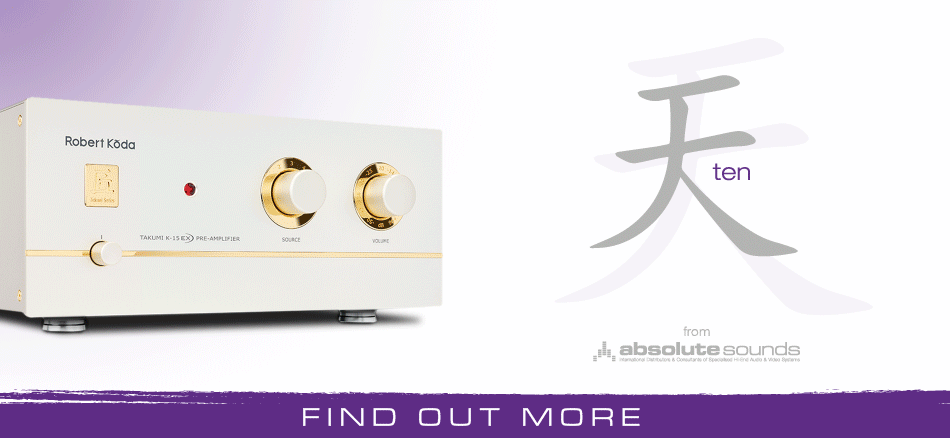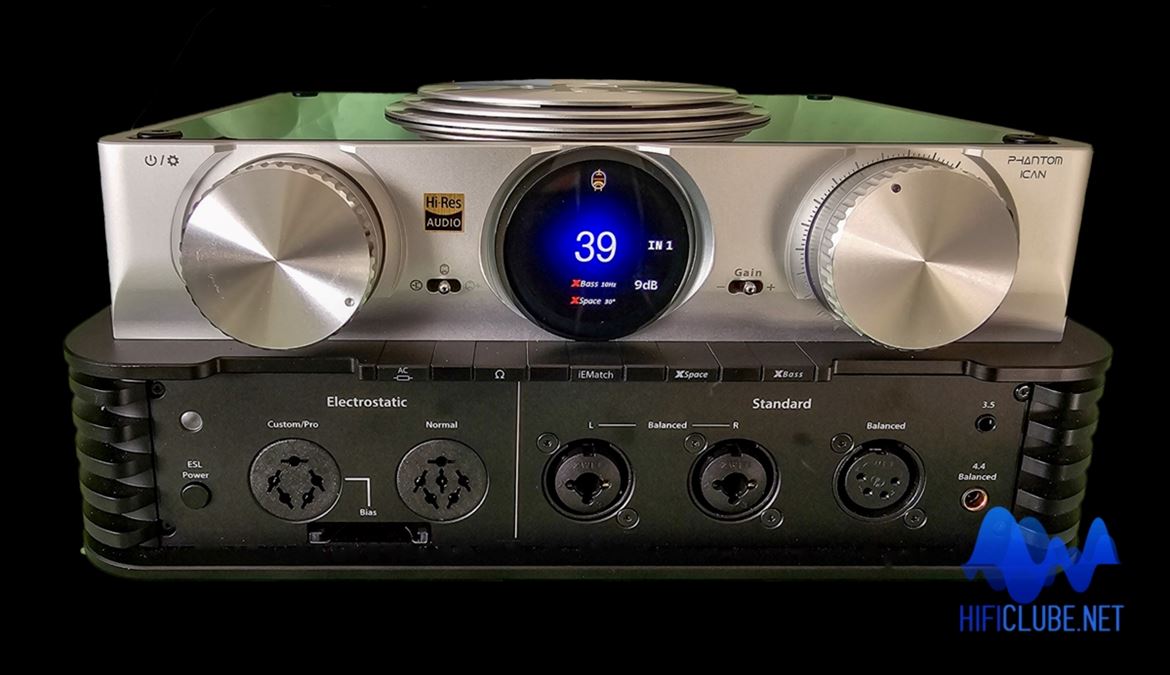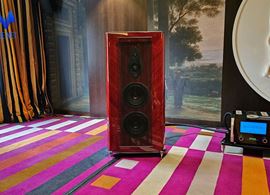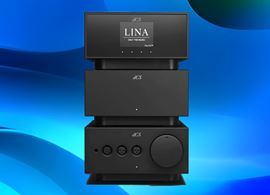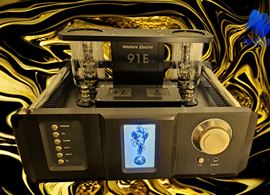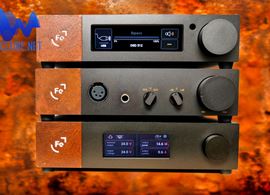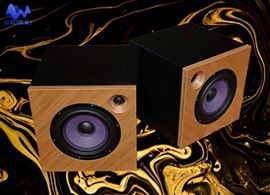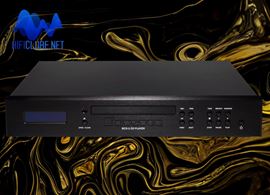Phantom is a highly advanced and inclusive analogue headphone amplifier (no DAC) and one of the most powerful and versatile options available on the market today. Its unbeatable specifications and sophisticated technology justify its price of 3,749.00 euros. Phantom serves as the ultimate power hub for all types of headphones.
Phantom’s ‘dual persona’ comes through both aesthetically and sonically. When I first saw it at HighEnd 2023 in Munich, I was quite shocked by its "vanilla and chocolate cake design".
According to iFI, it was inspired by the two-tone Rolls Royce Phantom, hence the name.
The Phantom’s ‘dual persona’ comes through both aesthetically and sonically.
Two tones, one unit
Upon first glance, the structure of the device may appear to be two separate boxes stacked on top of each other. However, it is actually a one-chassis unit that includes an aluminium-coloured top that rests on a black plinth with cooling fins, measuring 256 x 120 x 185 mm, that houses all the connections, both front and back.
The top floor of the unit consists of a circular TFT screen and two large rotary knobs that are located beneath a transparent smoked glass cover, which reveals the valves and circuits inside. Additionally, an aluminium ventilation chimney is situated in the middle of the glass plate to provide proper ventilation.
On the right front of the plinth, you can find the iFi Phantom which ensures compatibility with a wide range of headphones and audio sources. This includes 4-pin balanced, 3-pin balanced, 4.4 mm balanced (Pentacon), 6.33 mm positive phase, 6.3 mm inverted phase, and classic 3.5 mm.
Meanwhile, on the left front, there are exclusive outputs for electrostatic headphones, featuring a 6-pin normal bias output (230V) and a 5-pin custom-bias output. You can select the latter through the cards stored in a detachable storage plate on the rear. The storage plate comes disguised as a heat sink.
Lastly, on the lower rear, you'll find the normal array of analogue inputs, which include three RCA and one balanced XLR input. Additionally, there are one RCA and one balanced XLR output.
The Phantom is operated by using the two large rotary knobs on the top section. One of the knobs controls a 6-way motorised ALPS volume potentiometer: 4 tracks are used to adjust the volume for the balanced signal, and the other two are used for monitoring the volume control operation.
Push the knob on the left-hand side to switch the device on/off; or rotate it to select the desired source. The device turns off automatically (30 minutes to 3 hours preset).
Two small toggle switches flanking the TFT screen select the gain (0dB, 9dB, 18dB) and tube/solid-state modes. There will be a brief pause as the circuit switches to ‘Tube+,’ sometimes with an audible pop.
It also has a black keyboard with selection keys for adjusting AC and Impedance (for electrostatics), IEMatch (for IEMs), XSpace and XBass. More on these below.
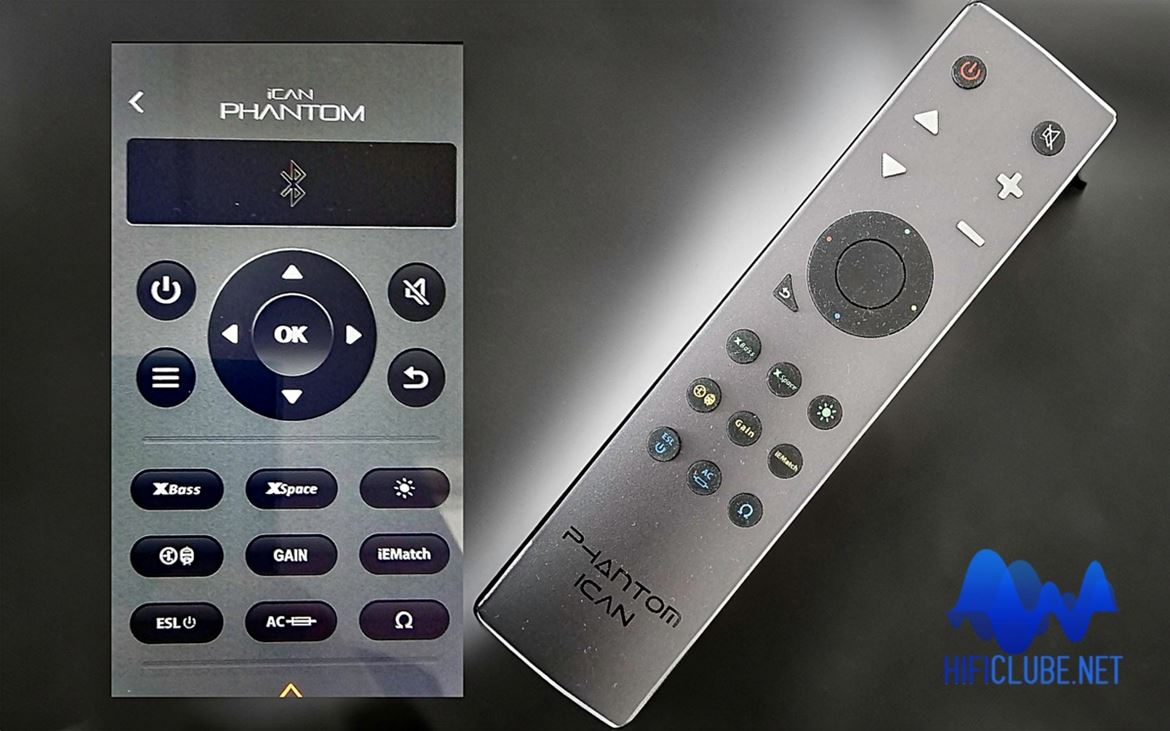
iCAN Phantom: iFI Nexis app and remote control. The app also provides information on the status of the valves.
Alternatively, you can use the remote control. There is also an iFI Nexis app that should work with the module built into the iCAN Phantom via Bluetooth, although I was unable to initialise it with my Android phone. However, it worked fine with my iPad (iOS).
The matching black, magnetic, detachable plate, which holds the six preset voltage bias cards (more on this below), may be used to cover the front of the plinth to hide the headphone connections when you it only as a preamp and don’t need to connect headphones. Otherwise, it rests in its secret bed on the back of the top section, as mentioned above, disguised as a heat sink.
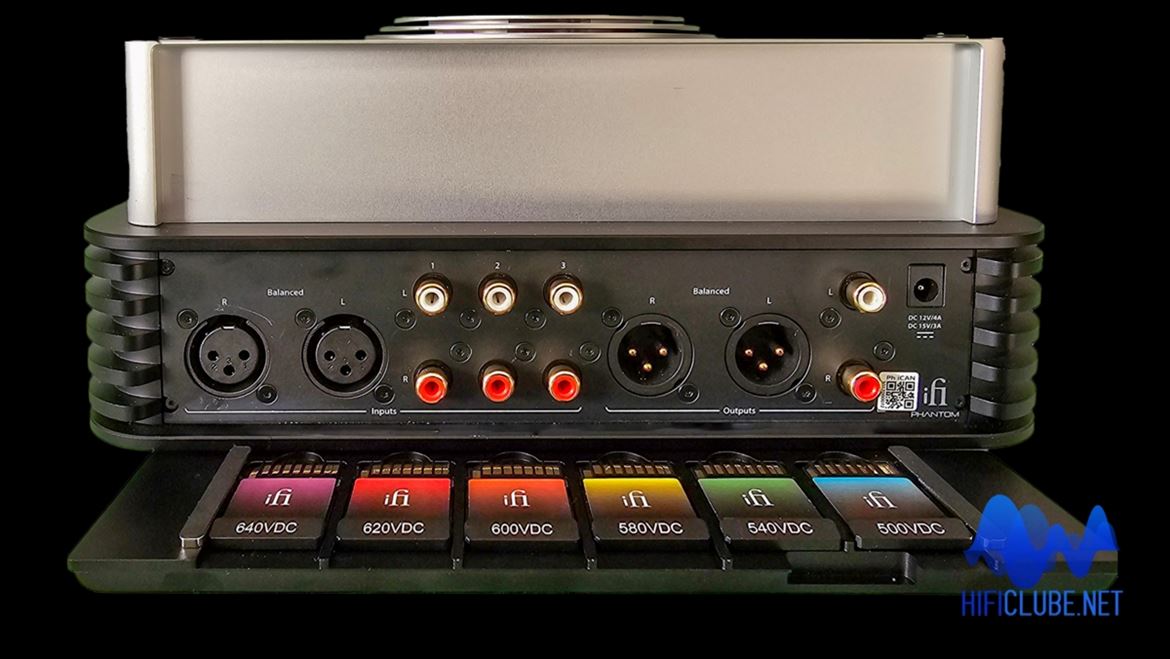
The bias card holder plate fits on the back of the upper module, or you can cover the headphone connections on the front of the lower module when using the Phantom only as a preamplifier.
Reference preamplifier
Phantom is also a preamplifier. You can hook it up to a power amplifier, or active speakers, and its analogue processing modes, XBass and XSpace can be used to create a holographic listening experience without the echo and reverb that come with DSP-based solutions. This fixes spatial distortion and makes imaging better.
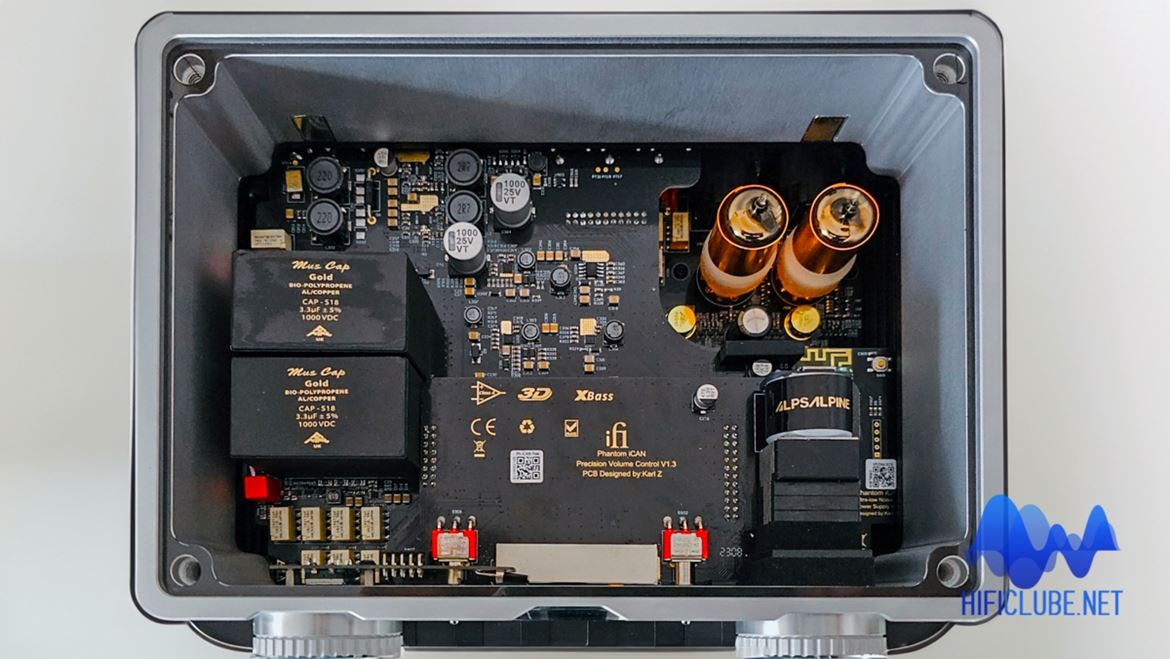
iFI iCAN Phantom (interior): perfect architecture and high quality components. The switchable first gain stage valves are glowing on the upper right corner.
Vacuum tubes or transistors
The unit features two separate input stages that give you the ability to instantly switch between solid state and GE5670 vacuum tubes to customise the sound in 'Tube' and 'Tube+'(less negative feedback) modes and allow for personal tuning.
The dual input stage is not new to iFI. It was developed from the previous flagship, iCAN Pro. The amplifier circuit is fully discrete, fully balanced with either tube or JFET switchable input, and has a bipolar transistor second stage, followed by a MOSFET-buffered bipolar class A power stage (with Class AB for low impedance headphones at very high levels).
According to iFI Audio, the tubes have a lifespan of 100,000 hours, which is far more than my listening capacity for the rest of my life.
Innovative technologies
But there are other patented iFI innovative technologies incorporated into the Phantom:
- Pro iESL energizer technology with six voltage settings for electrostatic headphones. The iESL Energiser was a separate component that provided high signal voltages for a wide range of electrostatic headphones, and now was integrated into the iCAN Phantom with bias cards, making it a world-first in terms of versatility. This is the only amplifier I know that can handle dynamic, planar-magnetic and electrostatic headphones at the same time. It includes adjustable gain (0dB, 9dB and 18dB, load impedance (16 ohms to 96 ohms), and IEMatch output attenuation for highly sensitive in-ear buds.
- The True Differential Balanced amp design is a further evolution of iFi Audio's PureWave circuitry concept. Impressive power and ultra-low distortion contribute to delivering a sound that is as close to the original recording as possible, so iFI claims.
- The Capacitive Battery Pack and iPower Elite Power Supply were also included in previous models to eliminate mains-borne noise from the audio signal.
Note: The Phantom is purely analogue, so much so that even the crosstalk (XSpace) processing is done in the analogue domain, so you won’t find the incorporation of the digital technologies of previous models like the iDSD.
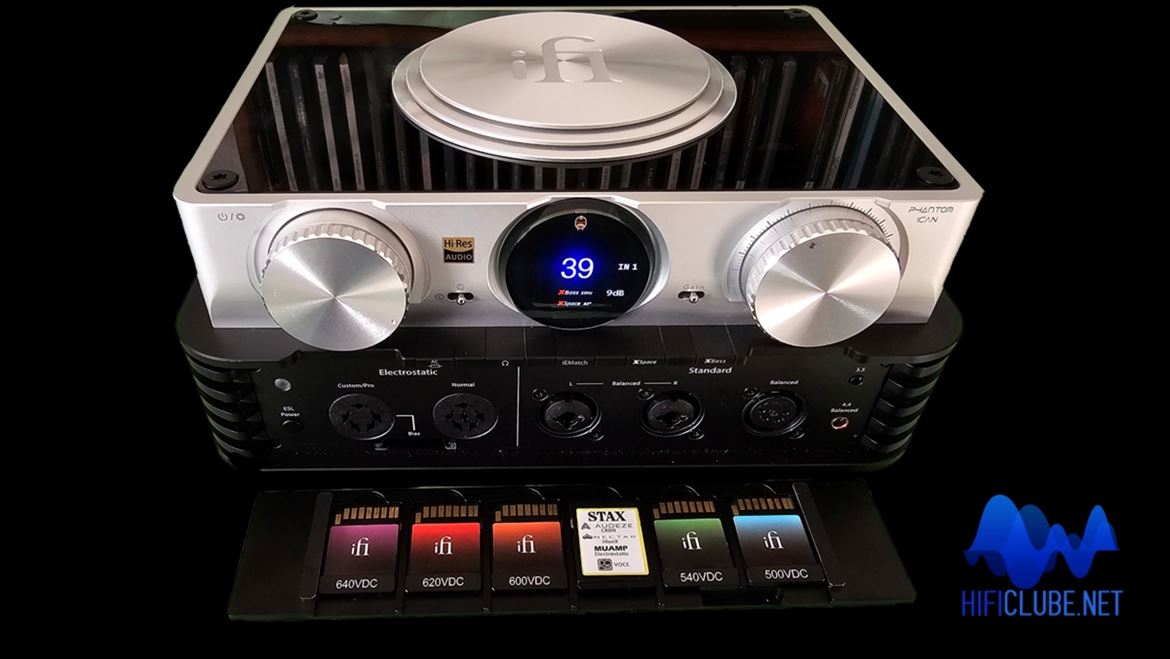
I used the Stax 580V card to select the correct voltage for the SR-X9000.
Cards up the sleeve
The Phantom may be a chameleon, but it's the astonishing 15W of power at the balanced outputs (6W single-ended) that elevates it above the competition: It will handle even the most demanding headphones with ease.
The Phantom can deliver 27 volts (into 600 ohms) in balanced mode (14 V single-ended) and offers normal (230 V) or pro-bias outputs for electrostatic headphones by inserting cards matched to the specifications or customised, according to this table:
- 500V Sennheiser Orpheus HE-90, Monoprice Monolith Electrostatic
- 540V Sennheiser HE-60, King Sound KS-H2/3/4
- 580V Stax Pro Bias ESHP, Audeze cran, Nectar HiveX, Muamp, VOCE 15 / 41
- 600V Koss ESP/950 & DROP Koss ESP/95X, HIFIMAN Jade
- 620V HIFIMAN Shangri-La/La jr/Jade 2
- 640V Sennheiser HE 1, HIFIMAN Shangri-La/La jr/Jade 2, Phenomenon Libratum/Canorum
This is a much safer solution for your precious electrostatics than a control knob to change the voltage. Now it is written on the card along with the headphone brand, so it’s fool-proof.
XSpace widens your horizons
I started by connecting my Hifiman HE1000 planar magnetics with a standard balanced cable and played with all the available toys to my heart’s content: XBass II, XSpace, Gain, Tube, and Tube+ modes.
Although powerful, the Phantom was even more comfortable feeding the Hifiman HE1000 with 9 dB of gain. I also tried 18 dB, which was too much. But the HE1000 definitively profited from a 10 dB boost at 10 Hz. The boost at 20Hz and 40Hz sounded like overkill to me, especially the latter, because you can hear its effect up to 200Hz, and that’s already male voice territory.
I had a great time playing with the XSpace mode, trying it out at 30, 60, and 90-degree angles. The sound quality felt like I was listening to speakers that were placed far apart. Although this setting may not work in every situation, I found the 90º angle to be particularly impressive while listening to Lars Erstrand's vibraphone in "I'm Confessing" from the Jazz At the Pawnshop album. It dramatically increased the stereo separation and made the music sound even more expansive. If you have live concert recordings, I highly recommend trying out this feature, as it can enhance the overall atmosphere and widen the soundstage.
The best analogy I can think of is that of a zoom lens: the wider the angle, the greater the depth of field, and the smaller and less solid the central image becomes. I found it curious that I liked the XSpace effect better with speakers than with headphones, with some sounds being heard well outside the confines of the speakers.
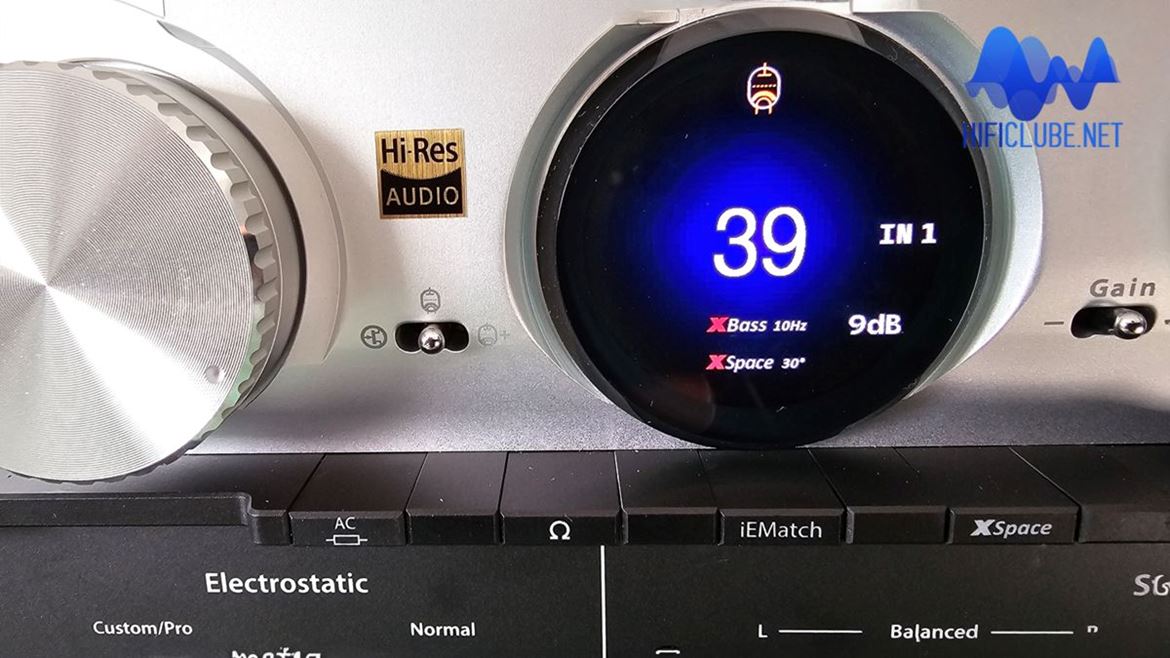
The round TFT display is very informative.
Vanilla or chocolate?
The solid-state vs. Tube and Tube+ input stage modes all sounded like vanilla to me at first, as in my test of the iCAN Pro.
With solid-state, it sounds more neutral, lively, and dynamic, but never harsh; the "Tube" mode sounds smoother, without apparent loss of transparency, with a slightly laid-back midrange and rounder highs and lows; the "Tube+" sounds warmer, with a captivating sensation of human presence in the voices, and boasts surprisingly fuller lows, even though the volume drops a little (rise it up to compensate). However, with "Tube+," I thought I heard harmonic distortion creeping in due to the reduction in feedback, affecting the ultimate degree of transparency.
Solid-state is like vanilla, while "Tube" adds a bit of hot chocolate, and "Tube+" provides a hint of delicious crème brulé.
During my leisurely listening sessions, I prefer to keep the toggle switch in the "Tube" mode, as I have grown fond of the more euphonic sound it produces. Yes, I know everything that feels good is either a sin or bad for your health, like cholesterol and second harmonic distortion.
However, when testing, I use the solid-state mode because it sounds more neutral, and my taste should not interfere with my evaluation.
Solid-state is like vanilla, while "Tube" adds a bit of hot chocolate, and "Tube+" provides a hint of delicious crème brulé.
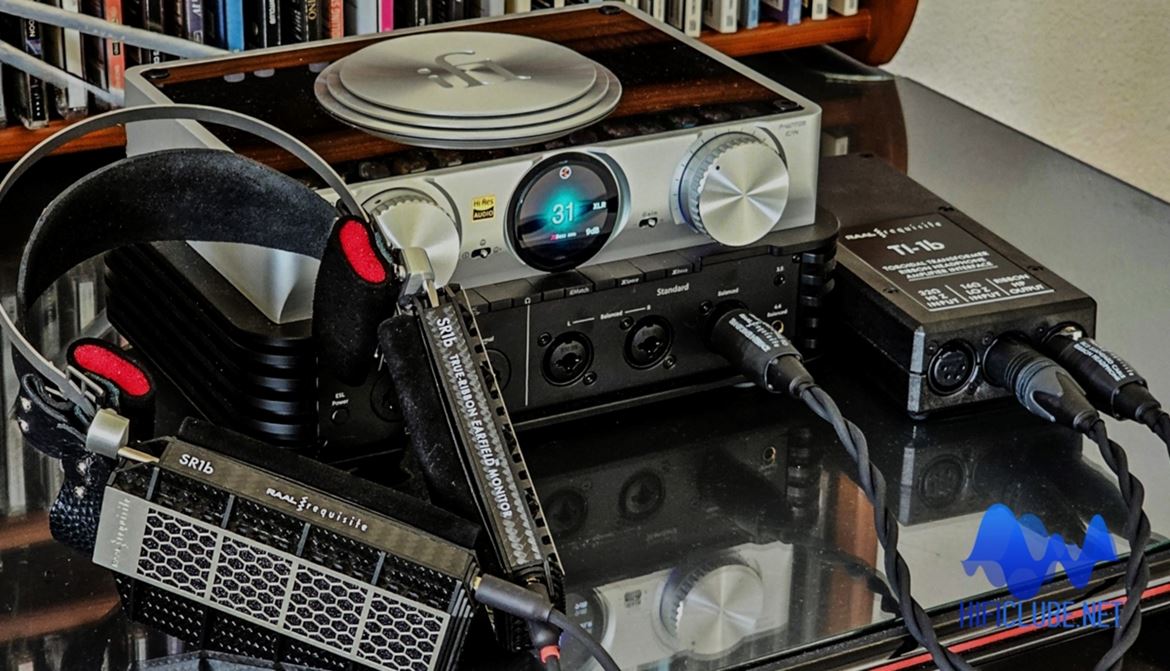
Phantom makes an excellent combination with Raal Requisite ribbons, as long as the impedance transformer and open-back response compensator are used.
Phantom of the Opera
I tried to be as comprehensive as possible, having listened to all types of headphones with a focus on my Hifiman HE1000 (planar magnetic), Stax SR-X9000 (electrostatics), Sf Pryma (dynamic), and a pair of discontinued ML MiKros 70 (IEM). I also tried a pair of Raal Requisite SR-1B for good measure. Would the Phantom be able to drive the Raal’s punishing 0.2-ohm load directly?
To be on the safe side, I contacted iFI tech support and got the following response from Jon:
‘You must use them with the TL1b adapter because, without it, the headphones will shut down the iCAN Phantom.’
So I used the required transformer and the open-back compensators (Raal review here) and got excellent results: dynamic, detailed, and smooth, with tight and articulate bass.
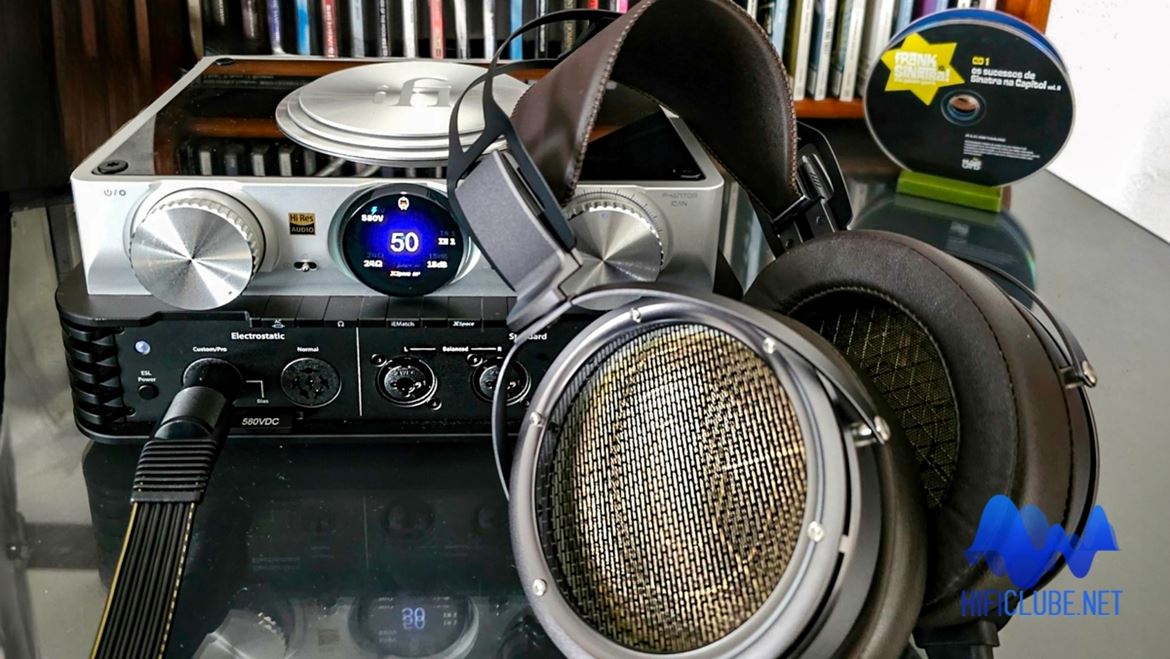
Phantom is the only universal headphone amplifier that can also 'energise' electrostatic models.
From ribbons to electrostatics
Despite both having unorthodox designs, or perhaps because of it, the Phantom/Raal Requisite duo remains my first choice for delivering a natural and seductive sound. Or so I thought, until I heard the superb Phantom/Stax SR-X9000 combination, and my heart was torn between the two. The Stax midrange sounds thinner, and less full-bodied than the Raal’s, but the degree of transparency is superlative. And how well the Phantom could drive the SR-X9000 electrostatics impressed me a lot.
How well the Phantom could drive the SR-X9000 electrostatics impressed me a lot.
I used the Stax 580V card to select the correct voltage and got the best results with 18 dB of gain and 16 ohms of impedance (it sounds louder). I also prefer to listen with the AC termination in either Pro or Full Mode, with the XSpace engaged at 30°.
Take the challenge
It is challenging to decide which transducer technology produces superior sound quality. However, the Phantom has impressed me with its performance, no matter what I have thrown at it, wiping the floor with allegedly hard-to-drive planar magnetics, soothing sensitive dynamic transducers; and nurturing electrostatics with precision and care.
I was lucky to have a pair of Sonus faber Duetto active loudspeakers for the preamplifier stage test. With XSpace mode activated, they were a perfect match for listening to live concert recordings. I'd say this is the best sound I’ve heard with the Duetto so far.
Important note: Connecting a pair of headphones will not switch off the output to an external amplifier or active speakers.
The iFI ICAN Phantom is the Swiss army knife you’ve been looking for until now.
Conclusion
If you own the iFi iCAN Pro or one of iFi's other digitally capable products, such as the iDSD Pro, you are already well-equipped.
However, suppose you aspire to be a reviewer or collector of headphones with different transducer technologies—dynamic, isodynamic, and electrostatic or full ribbon—and want to squeeze the last ounce of sound quality out of each one of them. In that case, the iFI ICAN Phantom is the Swiss army knife you’ve been looking for until now.
The excellent preamplifier is just the icing on the cake. And if, like me, you want to have your cake and eat it too, you must buy it because the Phantom has no close competition and qualifies as the strongest contender for our Headphone Analogue Amplifier 2023 Award.
Please note that the opinion provided is solely based on my listening experience. It is highly recommended that potential buyers conduct their own assessment before making an informed decision. Interested parties should contact a local dealer to schedule an appointment.
Official Quick Set-Up Guide video
For further information, please contact Smartaudio or your local dealer.

